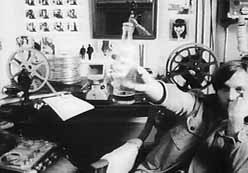
Movie poster for Hallelujah the Hills. |

Adolfas Mekas's Hallelujah the Hills (1963), for example, absorbs cinematic history into a modernist framework, skewing the narrative by resurrecting visual and aural strategies as old as cinema itself: iris shots, speeded-up movements, real location shooting, novice actors, and a use of music that recalls the silent film--not merely commenting on the action, but working with the visuals to create the film's mood.
The silent film reference is no mere conceit. Other films from this period--De Palma's The Wedding Party (1966) and Greetings (1968) and John Korty's Crazy Quilt (1965)--combine modernist, radical visuals (bizarre angles, discontinuous editing, double exposures and flash forwards) with silent movie techniques to exhilarating effect. These films recall early cinema in their sense of openness, of the fantastic possibilities of film for aesthetic pleasures and social change. This use of silent techniques, black and white photography, and music verifies this. Far from being reactionary, the films gain immeasurably from such references--the sheer joy of filmmaking, surely an important component of silent cinema, is obvious in the gleeful rule-breaking apparent in many of these films.
Hallelujah, the Hills, again like others here, has a subtext of deprivation, a purposeful exposure of the financial struggle behind the film and evident in what we see. Mekas allows the ragged edges to show, cutting through the artifice to say, yes, this is a film!--but exploiting its budget limitations in the name of realism rather than artfully disguising those limitations as in commercial cinema. In addition to the obvious class resonances, this approach also increased audience sympathy with the characters as the distance between viewer and viewed is eroded, the latter an important motif in all kinds of art of the 1960s and beyond.
page 1 of 3

Photo credits: Orion Home Video
|

 Foreign films, with their frank portrayals of sexuality, gained fresh currency; Italian neorealism, in particular, and then-cutting-edge directors like Godard, Bergman, and Fellini wielded a great influence on a new generation of filmmakers who were also filmgoers. (In Lionel Rogosin's case, we can add the critical role of film exhibitor--besides making independent films himself, he also provided a venue in which other such work could be seen, at New York's groundbreaking Bleecker Street Cinema.) Interest in all forms of "renegade" cinema--from social realist (Michael Roemer's Nothing But a Man, 1964) to early deconstructionist (Jim McBride's David Holzman's Diary, 1967) to taboo-breaking sexploitation (Herschel Gordon Lewis's Blood Feast, 1963)--increased exponentially, and we can now view these films as important components of the American independent narrative cinema--a movement that not only exploded existing narrative forms, but also prefigured aspects of the commercial and independent cinema of today.
Foreign films, with their frank portrayals of sexuality, gained fresh currency; Italian neorealism, in particular, and then-cutting-edge directors like Godard, Bergman, and Fellini wielded a great influence on a new generation of filmmakers who were also filmgoers. (In Lionel Rogosin's case, we can add the critical role of film exhibitor--besides making independent films himself, he also provided a venue in which other such work could be seen, at New York's groundbreaking Bleecker Street Cinema.) Interest in all forms of "renegade" cinema--from social realist (Michael Roemer's Nothing But a Man, 1964) to early deconstructionist (Jim McBride's David Holzman's Diary, 1967) to taboo-breaking sexploitation (Herschel Gordon Lewis's Blood Feast, 1963)--increased exponentially, and we can now view these films as important components of the American independent narrative cinema--a movement that not only exploded existing narrative forms, but also prefigured aspects of the commercial and independent cinema of today.


